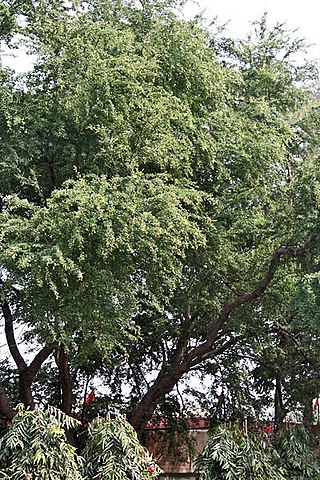
The Mimosoideae are a traditional subfamily of trees, herbs, lianas, and shrubs in the pea family (Fabaceae) that mostly grow in tropical and subtropical climates. They are typically characterized by having radially symmetric flowers, with petals that are twice divided (valvate) in bud and with numerous showy, prominent stamens.

Albizia is a genus of more than 160 species of mostly fast-growing subtropical and tropical trees and shrubs in the subfamily Mimosoideae of the family Fabaceae. The genus is pantropical, occurring in Asia, Africa, Madagascar, America and Australia, but mostly in the Old World tropics. In some locations, some species are considered weeds.

Dipteryx is a genus containing a number of species of large trees and possibly shrubs. It belongs to the "papilionoid" subfamily – Faboideae – of the family Fabaceae. This genus is native to South and Central America and the Caribbean. Formerly, the related genus Taralea was included in Dipteryx.

Pithecellobium dulce, commonly known as Manila tamarind, Madras thorn, monkeypod tree or camachile, is a species of flowering plant in the pea family, Fabaceae, that is native to the Pacific Coast and adjacent highlands of Mexico, Central America, and northern South America. It is also sometimes known as monkeypod, but that name is also used for several other plants, including Samanea saman. It is an introduced species and extensively naturalized in the Caribbean and Florida, as well as the Philippines and Guam via the Manila galleons. It has also been introduced to Thailand and South Asia, It is considered an invasive species in Hawaii.

Albizia lebbeck is a species of plant in the family Fabaceae, native to the Indian subcontinent and Myanmar. It is widely cultivated and naturalised in other tropical and subtropical regions, including Australia. Common names in English include siris, Indian siris, East Indian walnut, Broome raintree, lebbeck, lebbek tree, frywood, koko and woman's tongue tree. The latter name is a play on the sound the seeds make as they rattle inside the pods. Siris is also a common name of the genus Albizia.

Pseudalbizzia inundata is a perennial tree native to South America. Common names include maloxo, muqum, paloflojo, timbo blanco, timbo-ata, and also "canafistula" though this usually refers Cassia fistula.

Havardia albicans is a perennial tree of the family Fabaceae that grows to 5 meters tall. It is native to Mexico, the Caribbean and Central America, in regions around the Yucatan Peninsula. Common names for it include chucum and cuisache. It is reputed to be psychoactive. Its sap can be boiled and added to plaster to make waterproof stucco, and this may explain the longevity of Mayan plaster.
Pseudalbizzia pistaciifolia is a species of plant in the family Fabaceae. It is found in Colombia, Ecuador, and Venezuela.
Cassia aldabrensis is a species of plant in the family Fabaceae endemic to Assumption and Aldabra near the Seychelles. It is threatened by habitat destruction.
Chloroleucon chacoense, the palo barroso or palo overo, is a species of flowering plant in the family Fabaceae. It is found in Argentina, Bolivia, and Paraguay. It is threatened by habitat loss.

Chloroleucon is a genus of flowering plants in the family Fabaceae. Some authorities consider it part of the genus Albizia. Its name is derived from the Greek words χλωρóς (chloros), meaning "green," and λευκός (leukos), meaning "white."

Pithecellobium is a genus of flowering plants in the family Fabaceae. It includes approximately 23 species from the tropical Americas, ranging from Mexico to Peru and northern Brazil, including the Caribbean Islands and Florida.
Pithecellobium pithecolobioides, known as the granadillo de río, is a tree species in the legume family (Fabaceae).
Abarema glauca, the glaucous abarema, is a tree species in the legume family (Fabaceae). It is found in the Bahamas, Cuba, and Hispaniola. Abarema glauca is found most easily on the east coast of Dominican Republic, in Uvero Alto, north of Punta Cana.
Pithecellobium unguis-cati is a species of plant in the family Fabaceae. It ranges from Mexico through Central America and the Caribbean to Colombia, Venezuela, and Florida. It is known by many synonyms.
Zygia cognata is a tree species in the legume family (Fabaceae). It is found in Belize, Guatemala, and Honduras.

Archidendron bigeminum is a tree species in the legume family (Fabaceae). It is found in India and Sri Lanka. It is known as "kalitiya - කලටිය" in Sinhala.

Amphithalea is a genus of flowering plants in the family Fabaceae. It belongs to the subfamily Faboideae. It includes 41 species endemic to the Cape Provinces of South Africa.
Calliandra haematomma is a species of flowering plants of the genus Calliandra in the family Fabaceae. Calliandra pilosa is a synonym of C. haematomma var. glabrata.










